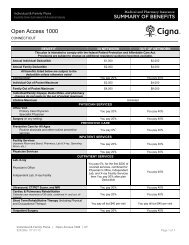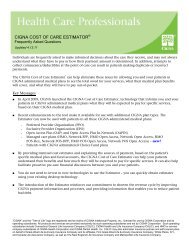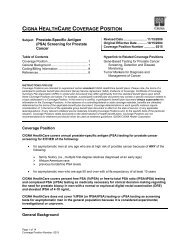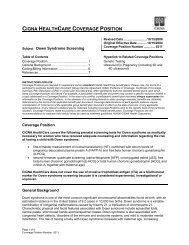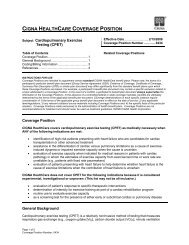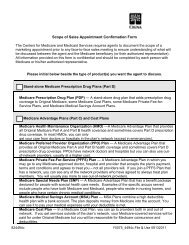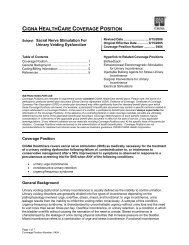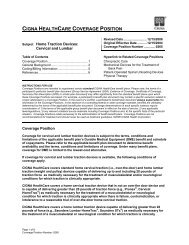<strong>MRI</strong>, and provides a framework for scoring inflammation and damage in RA and is useful for inclusion asan outcome measure in clinical trials (Ostergaard, et al., 1996; McQueen, et al., 1998; McGonagle, et al.,1999). OMERACT is currently working to standardize image acquisition, terminology, and possiblediagnostic and monitoring indications for <strong>MRI</strong> in rheumatoid arthritis. Lack of standardization contributesto the difficulty in assessing studies regarding the use of conventional strength <strong>MRI</strong> in the diagnosis andtreatment of rheumatoid arthritis.There are numerous, very small, comparative studies that validate low-field <strong>MRI</strong> is superior to x-ray in thedetection of rheumatoid arthritis (RA) findings (e.g., bone erosion, joint-space narrowing, synovitis);Yoshioka et al. (2006), Scheel et al. (2006) Ejbjerg et al. (2005), Crues et al. (2004), Lindegaard et al.(2001). A few small, comparative studies have evaluated the diagnostic capability of low-field MR withconventional MR in the detection of RA findings. Using conventional <strong>MRI</strong> as the standard reference,Ejbjerg et al. (2005) evaluated findings from a 0.2 T extremity-dedicated MR scanner in 37 patients withRA. <strong>Low</strong>-field MR (3D gradient echo sequence) wrist and metacarpophalangeal (MCP) joint imagingdemonstrated sensitivity, specificity, and accuracy for erosions of 94%, 93%, 94%; for synovitis, 90%,96%, and 94%; and for bone marrow edema, 39%, 99%, and 95%. The authors stated that low-fieldextremity-dedicated <strong>MRI</strong> provides similar information on bone erosions and synovitis as high-field <strong>MRI</strong>units. The low sensitivity of the low-field <strong>MRI</strong> unit for the detection of bone marrow edema may limit theusefulness of this type of scanner in RA if bone marrow edema is proved to be a pathological event ofmajor prognostic significance. But if bone marrow edema is only an interim phase between synovitis andbone erosion, this may not have major impact on the usefulness of low-field <strong>MRI</strong> in RA because theprecursor of bone marrow edema is generally accepted as being synovitis. The authors conclude that thelatter statement still needs to be validated in further scientific studies.Taouli et al. (2004) used a 0.2 T extremity-dedicated MR scanner to detect and grade bone erosions,joint-space narrowing, and synovitis in the hands and wrists of 18 patients with rheumatoid arthritis. Theauthors concluded conventional <strong>MRI</strong> and 0.2 T <strong>MRI</strong> showed similar results in terms of cross-sectionalgrading of bone erosions, joint-space narrowing, and synovitis in the hands and wrists of patients withrheumatoid arthritis. Different T2-weighted sequences for conventional and low-field were used. Also, thesmall number of patients evaluated limits the power of the statistical results.Savnik et al. (2001) used a 0.2 T extremity-dedicated MR scanner to compare diagnostic capability of lowto high-field <strong>MRI</strong> of arthritic wrist and finger joints. A total of 103 patients (group 1 = 28 patients with RA
<strong>MRI</strong> of the Knee Practice Guideline states “diagnostic quality knee <strong>MRI</strong> can be performed using a varietyof magnet designs (closed bore, whole body, open whole body, dedicated extremity) and field strengths.The coil’s placement should allow imaging of the major structures in and around the knee, or the coiland/or extremity should be repositioned during the examination to include any pertinent anatomy wherean abnormality is suspected. For example, when a quadriceps tendon abnormality is clinically suspectedor suggested by ancillary imaging findings in the knee, an additional set of images may be necessaryabove the knee after repositioning when using a dedicated extremity magnet. Certain MR systems (e.g.,low-field magnets) have inherently lower signal-to-noise ratios than others. When using such a system toperform knee <strong>MRI</strong>, other imaging parameters – such as the receiver bandwidth and number ofacquisitions – will require modification to ensure adequate spatial and contrast resolution for confidentdiagnosis, often at the expense of longer examination times. It may also be more difficult to achieveuniform chemical fat suppression on low-field systems. For some indications, imaging on a low-fieldsystem may be disadvantageous compared to a high-field system. For example, high-resolution imagesof articular cartilage are more difficult to achieve with low-field systems. Detection of other conditions, likemeniscal and anterior cruciate ligament tears, is probably less influenced by magnet strength and design”(October, 2005).<strong>MRI</strong> of the Shoulder Practice Guideline states “even when the imaging protocol is optimized for shoulderimaging on a low-field open system, subjective image quality will likely be inferior to that obtained with ahigh-field system. Various investigators using different equipment and scanning parameters have reachedcontradictory conclusions regarding the diagnostic performance of low-field-strength MR scanners forshoulder disorders. Some studies have found that the accuracy for complete and partial rotator cuff tearsand for labral abnormalities is not significantly different for open, low-field and closed, high-field systems,with careful attention to technique. MR arthrography can further enhance the diagnostic yield for shoulder<strong>MRI</strong> performed on low-field strength systems. Other investigators have found lower accuracy for theevaluation of disorders like SLAP tears, capsular abnormalities, and small rotator cuff tears with specificlow-field systems compared to high-field ones” (October, 2005).Appropriateness Criteria regarding Acute Hand and Wrist Trauma states “when high-field or low-fieldMR imaging is performed in addition to radiographs, radiographically occult fractures of the distal radiusas well as unsuspected fractures of the carpal bones are frequently demonstrated. MR imagingevaluation for radiographically occult scaphoid fractures can be performed with high-field or low-fieldequipment, using a whole-body imaging system and appropriate local coil, or using a dedicated extremityMR scanner. Unlike the case for the wrist, low-field MR imaging is less sensitive than radiographs forhand and finger fractures.The ACR Practice Guideline for <strong>MRI</strong> of the Adult Spine (2002) does not address weight-bearing,standing, upright, axial-loading or vertical positioning. It does not address field strength. Regardingdegenerative disc disease, ACR states <strong>MRI</strong> has proven to be the technique of choice for imaging ofintervertebral disc degeneration. Because of its greater contrast resolution and the ability to image in thesagittal as well as the axial planes, <strong>MRI</strong> is regarded as the diagnostic modality of choice for evaluation ofpossible disc herniation with a high sensitivity for demonstrating the presence of nerve root compression.As compared with CT (with or without myelography), the greater contrast resolution and multiplanarimaging capabilities of <strong>MRI</strong> enable more accurate demonstration of nerve root impingement beyond theroot sleeve and neural foramen. Regarding spinal stenosis, ACR states on both axial and sagittal MRimages, the sizes of both the spinal canal and the thecal sac are well demonstrated. The contents of thethecal sac (spinal cord, nerve roots) can also be assessed. These capabilities enable the use of <strong>MRI</strong> forthe evaluation of possible spinal stenosis with high sensitivity and specificity.American College of Rheumatology: A 2006 report of the American College of Rheumatology onextremity <strong>MRI</strong> in rheumatology notes that most of the literature “assessing the utility of peripheral joint<strong>MRI</strong> has used high-field, not low-field extremity <strong>MRI</strong>; therefore, actual sensitivity, specificity, andpredictive value of the low-field scanners available for the practicing rheumatologists are not known. Thebenefits of low-field strength extremity <strong>MRI</strong> for the diagnosis and management of rheumatoid arthritis arestill being elucidated”. In the American College of Rheumatology guidelines for the management ofrheumatoid arthritis (2002), radiography of selected involved joints is addressed, but no other type ofimaging is discussed.Page 9 of 17Coverage Position Number: 0444





